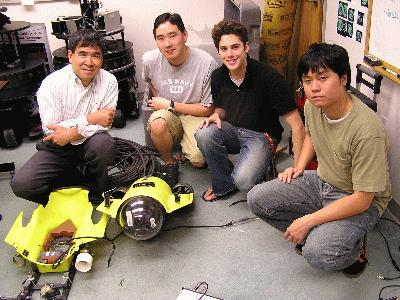
ISI ROV, ready to go below
Wei-Min Shen’s ISI Polymorphic Robotics Lab had a new assignment for its underwater Remotely Operated Vehicle (ROV): viewing the results of a marine biology experiment with pressure-shocked rockfish.
Professor Chris Lowe of California State University Long Beach attempted a 2-day demonstration June 13 and 15 with consequences for the fishing rules on the deepwater (200 feet) species living in offshore Southern California waters.For most species, fisherman are required to throw back fish below a certain size. But because rockfish live so deep below the surface, even small ones seem to be fatally wounded when they are caught — “typically their eyes are bulging and their stomachs hanging out of their mouths,” says Lowe, because the journey from the high pressure ocean depths to the surface inflates their swim bladders.
Lowe believes the damage looks much worse than it is. In earlier work, he’s shown than such fish actually recover readily when returned to depth immediately. With the help of ISI, he hopes to demonstrate this. On June 13, he took a boat out to catch a number of rockfish, putting them back into cages and returning them to depth.
On June 15, Shen and his team will brought ISI’s ROV out to the site and send it down for a look at the fish. If the fish showed the same kind of recovery that earlier fish have, it could lead to re- examination of the no-release regulations.
The ROV is an old design, built commercially more than 20 years ago, that Shen’s laboratory has reconstructed and modernized. “It never had a computer before we installed one.”
The ROV works regularly on missions at the USC Marine Biology station on Catalina, “and we’ve actually got a reputation now among marine biologists,” says Shen. “We get calls all the time to use it.”
Unfortunately on June 15, “Our robot went down to 250 feet, but unfortunately the current in deep water was so strong that the robot is not strong enough to move around as we wanted,” said Shen.
The group hopes to make changes to improve the Rover’s performance. 
Team ROV: left to right Wei-Min Shen, Harold Lim, David Alexander, Nick Kiswanto
Published on June 9th, 2006
Last updated on August 9th, 2021











